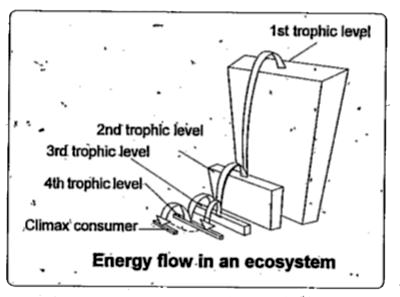Give an account of flow of energy in an ecosystem.
Text Solution
Energy Flow: Except for the deep sea hydro-thermal ecosystem, sun is the only source of energy for all ecosystems on Earth. Of the incident solar radiation less than 50 per cent of it is photosyn thetically active radiation (PAR). We know that plants and photo synthetic bacteria (autotrophs), fix Sun.s radiant energy to synthesise food from simple inorganic materials. Plants capture only 2- 10 percent of the PAR and this small amount of energy sustains the entire living world. So, it is very important to know how the solar energy captured by plants flows through different organisms of an ecosystem. All heterotrophs are dependent on the producers for their food, either directly or indirectly. The law of conservation of energy is the first law of thermodynamics. It states that energy may transform from one form into another form, but it is neither created nor destroyed. The energy that reaches earth is balanced by the energy that leaves the surface of the earth as invisible heart radiation.
The energy transfers in an ecosystem are essential for sustaining life. Without energy transfers there could be no life and ecosystems. Living beings are the natural proliferations that depend on the continuous inflow of concentrated energy.
Further, ecosystems are not exempted from the Second Law of thermodynamics. It states that no process involving energy transformation will spontaneously occur. unless there is degradation of energy. As per the second law of thermodynamics - the energy dispersed is in the form of unavailable heat energy, and constitutes the entropy (energy lost or not available for work in a system). The organisms need a constant supply of energy to synthesize the molecules they require. The transfer of energy through a food chain is known as energy flow. A constant input of mostly solar energy is the basic requirement for any ecosystem to function. The important point to note is that the amount of energy available decreases at successive trophic levels. When an organism dies, it is converted to detritus or dead biomass that serves as a source of energy for the decomposers. Organisms at each trophic level depend on those at the lower trophic level, for their energy demands.

Each trophic level has a certain mass of living material at a particular time, and it is called the standing crop. The standing crop is measured as the mass of living organisms (biomass) or the number of organisms per unit area. The biomass of a species is expressed in terms of fresh or dry weight (dry weight is more accurate because water contains no usable energy). The 10 percent Law The 10 percent law for the transfer of energy from one trophic level to the next was introduced by Lindeman (the Founder of the modern Ecosystem Ecology). According to this law, during the transfer of energy from one trophic level to the next, only about 10 percent of the energy is stored / converted as body mass / biomass. The remaining is lost during the transfer or broken down in catabolic activities (Respiration). Lindeman.s rule of trophic efficiency/Gross, ecological efficiency is one of the earliest and most widely used measures of - ecological efficiency: For example, if the NPP (Net primary production) in a plant is 100 kl, the organic substance converted into body mass of the herbivores which feeds on it is 10 kJ only. Similarly the body mass of the carnivore.-I is 1 kJ only.
|
Topper's Solved these Questions
Similar Questions
Knowledge Check
The flow of energy in an ecosystem is
AunidirectionalBbidirectionalCmultidirectionalDcyclicFlow of energy in an ecosystem is always
AunidirectionalBbidirectionalCmultidirectionalDno specific directionFlow of energy in an ecosystem is always
Aunidirectional.BbidirectionalCmultidirectionalDno specific direction
Flow of energy in an ecosystem is always
View SolutionDefine an ecosystem. Draw a block diagram to show the flow of energy in an ecosystem.
View SolutionDefine an ecosystem. Draw a block diagram to show the flow of energy in an ecosystem.
View SolutionExplain with diagrammatic representation flow of energy in an ecosystem.
View SolutionThe flow of energy in the ecosystem is:
View Solution
